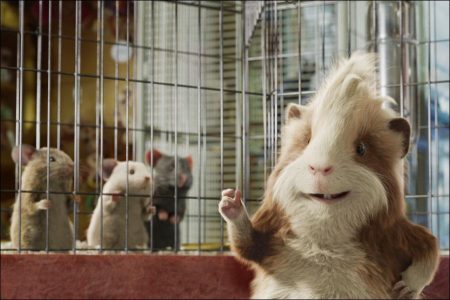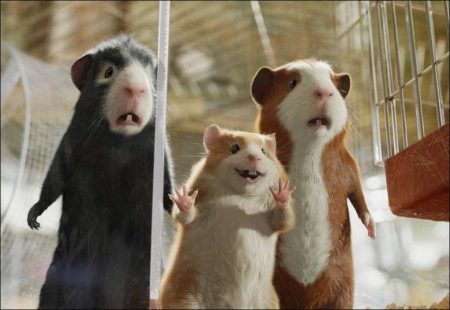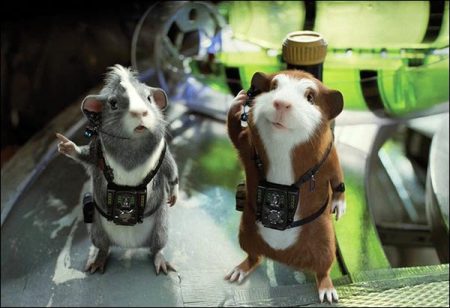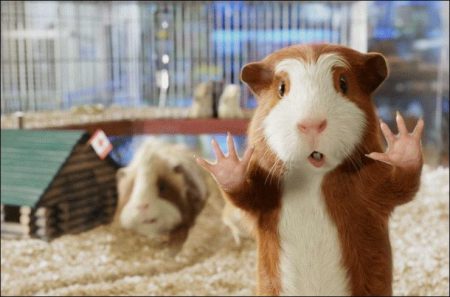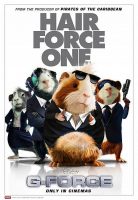The story about the latest evolution of a covert government program to train animals to work in espionage. Armed with the latest high-tech spy equipment, these highly trained guinea pigs discover that the fate of the world is in their paws.
Tapped for the G-FORCE are guinea pigs Darwin, the squad leader determined to succeed at all costs; Blaster, an outrageous weapons expert with tons of attitude and a love for all things extreme; and Juarez, a sexy martial arts pro; plus the literal fly-on-the-wall reconnaissance expert, Mooch, and a starnosed mole, Speckles, the computer and information specialist.
Armed with the latest high-tech spy equipment, these highly trained guinea pigs discover that the fate of the world is in their paws. Tapped for the G-Force are guinea pigs Darwin (voice of Sam Rockwell), the squad leader determined to succeed at all costs; Blaster (voice of Tracy Morgan), an outrageous weapons expert with tons of attitude and a love for all things extreme; and Juarez (voice of Penelope Cruz), a sexy martial arts pro; plus the literal fly-on-the-wall reconnaissance expert, Mooch, and a star-nosed mole, Speckles (voice of Nicolas Cage), the computer and information specialist. Along the way, the G-Force encounters myriad other members of the animal kingdom, including pet shop layabout Hurley (voice of Jon Favreau) and the rabidly territorial hamster Bucky (voice of Steve Buscemi).
Building The G-Force
“The genesis of the movie is interesting,” says director Hoyt H. Yeatman Jr. “I’d wanted to develop a project that broke new ground visually; it was actually my five-year-old son who came up with the spark of the idea. He brought home the class guinea pig from preschool and started talking about guinea pigs as soldiers, wearing uniforms and little army helmets. So I said, `Well, why not have a band of these guys who are secret agents?’
“We all laughed,” continues Yeatman, “but then I got on the internet and found some really interesting and bizarre stories about animals being trained by the American government for covert activities, including cats, dolphins, sharks and insects. It just lit up the imagination and off we went.”
“Out of the mouths of babes,” says producer Jerry Bruckheimer. “The idea was utterly off- the-wall, which was just fine with us, because it was also completely original. The amazing thing is that the fantasy element of `G-FORCE’ is based on certain realities. For years, the government has engaged in top-secret programs in which they train animals to help defend the nation-from dolphins detecting mines to cockroaches carrying recording devices. So we kicked it to the next level-what if a scientist figured out a way to not only train such animals, but to actually communicate with them?”
Building on the guinea-pigs-as-secret-agents concept, filmmakers created a G-Force that consists of three guinea pigs, a star-nosed mole and a house fly-all extremely dedicated to their work. “They know that at any given moment, the fate of the world may very well be in their paws,” says Bruckheimer.
But to make the movie work-and be somewhat believable-the animals had to communicate somehow. Enter character Dr. Ben Kendall, the genius behind the film’s G-Force. “His breakthrough is the fact that they actually have little headsets, and the headsets allow them to speak fluent English,” says Yeatman. “In the movie, animals have always been able to understand English. In their world, they speak just like we do, but to communicate with humans, they have to wear that headset.”
Dr. Kendall’s secret operation includes an amazing array of gadgetry that aids in G-Force’s efforts. From motorized exercise balls to night vision to tiny militarized PDAs, the G-Force is aptly outfitted to save the world. “They have a base-jumping low-altitude parasail,” says Yeatman. “When they need to jump to the top of the roofs they have a rocket assist. In the world of `G-FORCE,’ the guinea pigs have lots of really cool gizmos.”
The G-Force’s training and high-tech spy equipment are put to the test when they uncover a billionaire industrialist’s sinister plan to destroy the world. Duty calls, and the G-Force springs into action.
Behind The G-Force
Much like the fictional G-Force, the movie “G-FORCE” employs the latest technologies, taking the film to the next level. But producer Jerry Bruckheimer says there’s another aspect of the film that really makes the four-legged G-Force work. “It’s the humans who bring these animals and their world fully alive,” says Bruckheimer.
Nicolas Cage (“Knowing,” “National Treasure”), a lifelong fan of animation, provides the voice of Speckles, the blind and brilliant, star-nosed mole. “G-FORCE” was to be the actor’s sixth collaboration with Bruckheimer (with “The Sorcerer’s Apprentice” soon to follow as the seventh), but one unlike any of the others. “Jerry showed me pictures of the `G-FORCE’ characters and said I could play any role I wanted,” says Cage.
“When I saw Speckles, something about it got to me, and I thought I could do something interesting with the voice. It was important to me to create a new voice that was unrecognizable from my own vocal patterns. It was also important to me to go into an area that had kind of a zany intensity. To me, that’s what would make Speckles fun to play, and hopefully fun for the audience.
“One of my favorite actors is Mel Blanc,” continues Cage, referring to the great vocal talent behind Warner Bros. cartoon characters Bugs Bunny, Daffy Duck, Elmer Fudd and Yosemite Sam. “He was a marvelous character actor. We knew him only from his voices, so I thought it would be fun to create a whole new voice for this marvelous looking little mole in `GFORCE.’”
“Nic Cage has created a terrific voice for Speckles, sort of going back to a 1930s kind of character,” says Bruckheimer. “Then there’s Sam Rockwell, who also has a wonderful voice, powerful and strong, as Darwin, the team leader.”
“Oh, it’s very strange,” admits Rockwell about bringing a non-human character to life. “But when they said `action guinea pig movie,’ I showed up-I was like, `I’m there!’ Darwin is a superspy and has sort of a Steve McQueen guinea-pig vibe, so it’s fun to play an action hero.” Rockwell (“Frost/Nixon,” “The Assassination of Jesse James by the Coward Robert Ford”) had experience with guinea pigs, having had one for a pet when he was a kid. “His name was Ralph and he used to bite my finger a lot,” recalls the actor.
“It didn’t feel good. I don’t know if Ralph liked me or not, but I think he had some emotional issues. Darwin is much more well-adjusted.”
Rockwell was able to record some of Darwin’s scenes with his friend and colleague Jon Favreau (“The Break-Up,” “Four Christmases”). The character actor and director of the recent smash hit “Iron Man” provides the voice of the fat and happy Hurley who members of the G-Force meet up with in a pet store.
“I’m the flatulent comic relief in the film,” says Favreau. “I think that if you’re going to play a guinea pig, you want to be a funny guinea pig. Hurley thinks that Darwin is his brother, based on a birthmark that they both have, and he’s taken quite a shine to the guy.
Hurley has grown up in a pet shop, never adopted by a family, and he’s a bit needy for attention and love. GForce becomes his de facto family, and Darwin his long-lost brother, even though he probably isn’t. I think Hurley gives an emotional center to the group.”
Favreau was attracted to the material for reasons both artistic and personal. “It’s fun to do voiceover because you get to be a part of the movie but don’t have to deal with things like going out of town, living in hotels, getting into makeup. Also, I have three kids, so it was a chance to be part of something that my family could enjoy watching together.”
Tracy Morgan (TV’s “30 Rock,” “The Longest Yard”) was called on for the voice of Blaster, a key member of the G-Force who’s known for his tough attitude and weapons expertise. “Blaster is an adrenaline junkie. He’s always ready to let the fur fly,” says Yeatman. “Tracy brings the same sense of humor and comedic timing he’s used in `Saturday Night Live’ and `30 Rock.’”
Oscar winner Penélope Cruz (Woody Allen’s “Vicky Christina Barcelona”) provides the voice of G-Force sexy martial-arts pro Juarez. “Juarez is a knockout you can’t knock out,” laughs Yeatman about the character. The director says Cruz was the perfect voice for Juarez. “Penélope Cruz is an amazing actress. I think this is the first time that she’s ever done an animated character, but she brought a lot to the role. She has a beautiful, velvety voice, which is just amazing. It was great working with her.”
Steve Buscemi (“Ghost World,” “I Now Pronounce You Chuck & Larry”) was tapped to play Bucky. “Bucky is a fun, angry hamster,” says Bruckheimer. “Steve did it to perfection.”
“Steve Buscemi is a great, great guy,” adds Yeatman. “He’s obviously done voices before. Bucky was a character that came from the evolution of the story. In the original script, he was just one of the pet store animals off in the corner. But as we got into it, we realized that Bucky could be a very cool little nasty hamster-fun, you know? Steve Buscemi was perfect for that bipolar character. He did a very good job.”
Live-Action Talent The live-action cast was comprised of comedic and dramatic talents who had become familiar faces on screen, television, stage and, in the case of Zach Galifianakis, the film’s Dr. Ben Kendall, clubs and the internet. One of the country’s most original and decidedly offbeat performers, Galifianakis has very recently expanded beyond cult status with his unfettered, scene-stealing turn as the dubiously lovable, quite literal wild card alongside Bradley Cooper and Ed Helms in the smash hit comedy “The Hangover.”
“When I saw Zach’s work, he struck me as being a total original,” says Bruckheimer. “I thought that along with the humor, was a keen intelligence which made him perfect to play a lovable if slightly eccentric scientist like Ben.”
Galifianakis claims to have trained hard for his role of the slightly portly scientist who creates G-Force. “I work out, I’m a gym rat, and I also go to Souplantation a lot. I know that a lot of actors talk about it, but I had to gain 35 pounds for this role. I was going to wear a prosthetic for some of the early parts of the shoot, but then I eventually gained the weight.” Galifianakis’ training regimen? “I do about three pushups a day. I think every little bit helps. I eat about ten Cliff bars a day, then I move on to six Balance Bars, then a couple of bacon smoothies.”
As for Will Arnett (TV’s “Arrested Development”), another hugely talented comedian and actor cast in the film as the utterly humorless Special Agent Kip Killian, “When asked to describe `G-FORCE’ to friends and family, I say, `Have you ever thought that guinea pigs could talk?’ Most of them say `no,’ and I say, `well, they do. It can happen, and Mr. Bruckheimer can make that happen!’”
Arnett describes his character as “a by the book guy-he’s a government man, and he believes that the American people need to be served in a very honest and forthright way. He doesn’t agree with some of the programs that have been in place, and he’s looking to cut some of the fat and do the right thing. When he comes across Dr. Kendall’s G-Force program, he’s not down with it and that really irks him. And when he tries to shut it down and Ben Kendall goes behind his back, it does not go over well with Kip Killian.”
Bill Nighy (“Pirates of the Caribbean: Dead Man’s Chest,” “Pirates of the Caribbean: At World’s End”) was tapped to play Leonard Saber. “You have a choice in trying to describe what `G-FORCE’ is. You either go into a very long explanation which gets very technical, and they are more mystified. Or you say `I’m in a guinea pig movie,’ which is the quick way. Then, of course, they think you’re going to be a guinea pig, or the voice of a guinea pig, and I have to explain that no, in fact, I play an industrialist named Leonard Saber who’s bent on world domination. Then it becomes clearer.”
Kelli Garner (“Lars and the Real Girl,” “Taking Woodstock”), the gifted young actress who portrays veterinarian Marcie Hollandsworth, describes her character’s relationship to the animals of “G-FORCE” as “motherly.” “I think every good woman, no matter how old, has a maternal instinct.”
Completing the live-action line-up are Jack Conley (“Fast & Furious,” “Traffic”), Gabriel Casseus (“Black Hawk Down”) and Niecy Nash (TV’s “Reno 911!” and “Clean House”).
Magic of G-Force
Talking Guinea Pigs in Three Dimensions Director Hoyt H. Yeatman Jr., one of the most innovative visual effects artists in his field, had already worked in that capacity on numerous Bruckheimer productions. “I’ve known Jerry since `Crimson Tide,’” says Yeatman. “I went on to do `The Rock,’ `Armageddon’ and `Kangaroo Jack’ for him. Jerry always likes to be on the edge in everything that he does; he has no box around him.”
“Hoyt brilliantly decided to make the computer animated animals as photo realistic as possible instead of looking like cartoon critters,” says Bruckheimer. “He’s won an Academy Award®, received a technical achievement award from the Academy, and he received an Oscar® nomination for his work on Disney’s `Mighty Joe Young,’ in which he created one of the most authentic CG animals ever put on screen. We always push the envelope for visual effects and we encouraged Hoyt to go to the edge and beyond on `G-FORCE.’”
“We used the highest end computer graphics, but it was all character driven,” says Yeatman. “We used both live-action and virtual worlds, and at the end of the day, the audience won’t know the difference.”
One way in which the filmmakers ensured that audiences felt completely enveloped in the adventure and comedy of “G-FORCE” was to employ the most highly developed new form of immersive 3D from Sony Pictures Imageworks. “We looked at new 3D technologies to see what they could bring to the film, and we’re sure that audiences will have an experience unlike any they’ve had in the past,” says Bruckheimer.
“I think that what this film offers in 3D that others don’t is that it’s a liveaction film with animation,” says Yeatman. “To dimensionalize a mixture of live action and animation is a big deal. I think we’re breaking new ground in that respect. 3D adds another layer; it’s almost like going from black and white to color, from silent to sound. Being on the edge is always fun, but kind of scary, too. So when the idea of 3D came up, we had to do some hard thinking and produced a lot of new tools to be able to make that happen.
“One innovation that we’ve accomplished is breaking the frame,” continues Yeatman. “Our characters are free to bust out of the aperture frame, which really brings the 3D to life. It comes right out, literally, into the audience, which is a great effect.”
“Everyone’s trying to push the boundaries,” says two-time Academy Award-winning visual effects supervisor Scott Stokdyk of Sony Imageworks. “We want the audience to have a great experience that’s different from their home theatre. At the very start of the project, Hoyt did some 3D tests and projected it on a big screen. It was a close-up of a guinea pig and it really came to life in a way that’s not possible in two dimensions. “Sony Imageworks has done a lot of work with fully animated features like `Open Season,’ `Surf’s Up,’ `Beowulf’ and `The Polar Express,’”
Stokdyk continues. “But to do that on an action feature which combines live action and animation is a whole other ballgame. It involves a lot of advanced technology which breaks new ground. It’s a difficult process, particularly with a movie as complex visually as `G-FORCE,’ but I think it gives the audience a really big bang for their buck at the end of the day.”
“3D has come a long way since the 1950s,” says Sony Imageworks senior visual effects producer Buzz Hays. “Even in the last 10 years we’ve made tremendous advancements. The characters lend themselves to the 3D environment, and certainly the action does. It’s just a really fun experience.”
Adds 3D visual effects supervisor Rob Engle, “Digital technology is the reason for the great progress of 3D, as well as digital exhibition, which is superior to anything we’ve had before. The whole point of showing a 3D movie is that we’re actually showing you two movies, one for the left eye and another for the right eye. The digital technology allows us to do that in a way which is leaps and bounds better than anything we could do with film technology in the past.
“What makes `G-FORCE’ so wonderful for 3D,” continues Engle, “is that there are so many moments where you can get in the action and experience them the way the animals do, whether they’re driving around in their little balls, or just watching them shake a little water off their fur.”
“Building the characters and making them look like real guinea pigs which do extraordinary actions was a critical part of what we did,” explains Stokdyk. “This is a very performance-driven movie; we knew that making all of their personalities unique was crucial. We went through a series of animation tests to give them their own sensibilities, so that their looks matched their personalities.”
G-Force Gadgetry
Filmmakers Get Creative In addition to the magic which Hoyt Yeatman and his team would create in the digital universe, he and director of photography Bojan Bazelli were also creating a panoply of innovative camera equipment to allow the audience to see the world from the animals’ points of view. Bazelli, an enthusiastic and energetic artist who was eager to take on the film’s challenges, already had some experience combining live action with CG animation. “I found it very helpful that I had a strong background in commercials, where we employ lots of CGI elements and post-production work. It was still more complex than anything else I had done, comprehending and visualizing things that don’t exist. Hoyt and I agreed that our approach would be to just shoot the film as if all of the characters were real.”
For the film, Yeatman and Bazelli concocted a Rube Goldberg-like menagerie of what the director admits were “very bizarre” camera rigs to essay a view of the world from the animals’ points of view. Among the innovative techniques utilized was Yeatman’s HDRI Cam invention called the “Chirpy Cam,” so named because of the tweeting sound it makes. “The Chirpy Cam shoots 360 degrees in every possible level of exposure,” explains Bazelli, “so that it re-creates every part of the set and how it was lit, so that it can be exactly matched with the CG work.”
There was also “Mooch Vision,” a camera which re-creates the point of view of Mooch as he flies. “Mooch Vision was a 35-millimeter camera with a very wide angle fisheye,” explains Yeatman.
On Location
Environments Real and Virtual It was the task of production designer Deborah Evans, supervising art director Ramsey Avery, and their expansive art department team to create the environments, both real and virtual.
“We designed the sets in close conjunction with Hoyt, because that’s his world,” says Evans. “We had a lot of meetings with Hoyt and the visual effects department to work out how to combine the real sets with their virtual needs.”
In fact, even the real sets began in virtual form. “We built virtual sets in the computer,” explains Evans, “which we would then hand off to visual effects and the pre-visualization artists so they could create animatics with Hoyt’s hand-drawn storyboards. That way, when we designed the sets, it would be perfect for the action.”
Adds Avery, “It takes a lot of going through storyboards and figuring out exactly what’s real in a frame and what’s not real in a frame.”
The largest set created for the film was Dr. Ben Kendall’s impressive, albeit jerry-built, Biological Intelligence (B.I.O.) Lab, constructed in an old, converted locomotive factory in downtown Los Angeles (in the film, the B.I.O. Lab has the false cover of “ACME Exterminators”). “We designed the lab so that it looked like it was cobbled together on a budget by Ben out of salvaged military containers and aeronautical parts,” explains Evans.
The boxy environments for the GForce training and living spaces were all fully constructed, right down to the last simulator and beach chair. The B.I.O. Lab has a central workstation which controls the training facilities, including elliptical trainers, a mini RV driving simulator, wind tunnel and pneumatic dispatch, which resembles old-fashioned units in office buildings utilized to move mail throughout the building, but in this case, is intended for quick G-Force escape. In fact, the tubes were part of the old locomotive factory, cleverly adapted by the filmmakers.
“The whole G-Force world is in containers,” says Evans. “We built a gymnasium for Darwin and Juarez out of an executive aircraft’s fuselage. Everything was fabricated out of metals, scraps and recycled electrical components.
“Speckles is the tech/communications guy,” continues Evans. “We used old cell phones and telephone parts for his environment, and unlike the other members of GForce, who sleep in bunk beds, Speckles sleeps in an old cereal box. Blaster’s the rock-and-roll guinea pig, so he has a little boom box in his environment, rock posters and a bigscreen TV.”
The theme of living and working in recycled containers extended to Ben Kendall’s house. Evans and Avery found a home in Redondo Beach, Calif., constructed entirely from shipping containers. In contrast was Leonard Saber’s mansion, which was shot at the Sharpe residence at Lucky Dog Ranch in Somis, Calif. The sleek, post-modern structure was designed by world-renowned architect Zoltan Pali. For “G-FORCE,” however, the visual effects artists amended Pali’s design by digitally adding a second story to the one-floor home.
Other locations and sets for the film included the colorful Elia’s Pet Shop, which temporarily houses G-Force and introduces them to a host of other animals, including Hurley, a delightful trio of mice and a not-so-delightful snake. The exterior of the shop was actually filmed in the real Elia’s-a neighborhood fixture in East Los Angeles-and a fully tricked-out interior set was then designed by Evans and filmed at The Culver Studios, which also housed Saber mansion interiors, Ben’s home laboratory and the interior of the command vehicle, mounted on a highly sophisticated, computeroperated, six-axis motion base. The Goodman house, where Juarez and Blaster are temporarily adopted, was on a leafy street in Pasadena. The suburban street thrown into nighttime chaos by marauding household appliances was filmed in Stevenson Ranch north of Los Angeles
Taking Technology To The Big Screen
Gizmos, Gadgets and Scary Household Appliances Invade “G-FORCE” Every secret agent has to have his gear, and the members of G-Force are no exception. Never mind that they’re a fraction of the customary size for such accoutrements. “G-Force is all tricked out,” says Bruckheimer. “They have parachutes, blowtorches, their own communication system. Mooch the Fly has the latest in surveillance technology. James Bond would be envious.”
“Ben Kendall is a tinkerer and an adventurer at heart,” says Yeatman. “He has the equipment to build the more advanced technology that the government maybe wouldn’t have funded. So he firmly believes in equipping G-Force with the latest and best equipment, not to mention a Rapid Deployment Vehicle, or RDV, which looks like the militarized version of the transparent balls that hamsters and guinea pigs roll around in for exercise. We use them in a terrific chase scene.”
Each member of G-Force has their preferred gears and gadgets. Darwin utilizes nightvision goggles, a plasma cutter and an all-important PDA. Blaster has his scuba equipment (including a nifty aqua scooter) and grappling hooks, and is a beast for commandeering toy remote-controlled cars. Juarez, as a martial arts expert, generally relies on her own skills, but has a more than passing familiarity with scuba gear, whirling bolos and parasailing. Speckles, of course, has his computer. And Mooch, a genius at surveillance and communication, has his nano-camera, which can transmit fly-on-the-wall imagery to the rest of the team.
No detail went unexplored by Yeatman and his design team. “Speckles has a very unique work station,” says the director. “As a star-nosed mole, he has very unique digging claws, so we knew that a normal computer keyboard wouldn’t work. We had to ergonomically design something that a mole could use.”
Deborah Evans and her department were also responsible for the design of G-Force’s gadgets, gizmos and gear, as well as the Sabersense household appliances, with their retro look which give way to monstrous manifestations once Saber puts his sinister plan into action. In the world of “G-FORCE,” Saberling brand electric coffee makers, refrigerators, mixers, waffle makers, blenders, toasters, vacuum cleaners, washing machines, dryers and microwave ovens all have a terrifying (and terrifyingly funny) flip side when the right (or wrong) buttons are pushed. “The appliances reference classic industrial design when everything was made out of metal,” explains Evans.
Adds supervising art director Avery, “Each of the appliances, when they come to life, has a little bit of animal feel to it. The washer and dryer are like a gorilla. The toaster spits its heating coils at you. The coffee maker sprouts legs and walks around in a very strange kind of Frankenstein manner. The microwave tries to lure one of our characters into it with some cake.”
Having a field day with the monstrous appliances and other action elements of the film were stunt coordinators Brian Machleit and Doug Coleman, and second unit director Kenny Bates. Machleit orchestrated such mayhem as an FBI Hostage Rescue Team assault on Leonard Saber’s futuristic mansion, while Bates coordinated and shot a car-chase scene between Agents Carter and Trigstad in a black SUV and Darwin, Juarez and Hurley in the G-Force Rapid Deployment Vehicle. “The car chase is a classic mainstay of action movies,” says Bruckheimer. “But we never like to repeat ourselves. Bullitt and Popeye Doyle never had to chase three guinea pigs in an RDV.”
For Bruckheimer, Yeatman and their talented group of actors and behind-the-scenes artists, it was all in a day’s work. “I think that `G-FORCE’ is built for the whole family,” says Yeatman. “People will love seeing these animals in an action movie setting, and will probably look sideways every time they turn on a blender!”
G-Force (2009)
Directed by: Hoyt Yeatman
Starring: Nicolas Cage, Steve Buscemi, Tracy Morgan, Bill Nighy, Will Arnett, Zach Galifianakis, Kelli Garner, Penelope Cruz, Piper Mackenzie Harris, Justin Mentell, Niecy Nash
Screenplay by: The Wibberleys, Ted Elliott, Terry Rossio, Tim Firth
Production Design by: Deborah Evans
Cinematography by: Bojan Bazelli
Film Editing by: Mark Goldblatt, Jason Hellmann, Bud Smith, M. Scott Smith
Costume Design by: Ellen Mirojnick
Set Decoration by: Leslie E. Rollins
Art Direction by: Ramsey Avery
Music by: Trevor Rabin
MPAA Rating: PG for some mild action and rude humor.
Distributed by: Buena Vista Pictures
Release Date: July 24, 2009
Visits: 197
